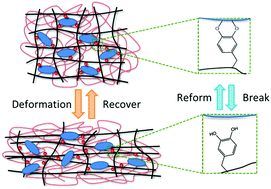Recovery property of double-network hydrogel containing a mussel-inspired adhesive moiety and nano-silicate†
Abstract
Although double network (DN) hydrogels are extremly tough, they are irreversibly softened during large strain deformation. We incorporated a mussel-inspired adhesive moiety, catechol, and a synthetic nano-silicate, LAPONITE®, into DN to examine the effect of strong, reversible crosslinks on the DN's ability to recover its mechanical properties during successive loading cycles. The introduction of catechol and LAPONITE® drastically increased the compressive strength and toughness of DN without compromising the compliance of the hydrogel. After 2 hours of recovery at room temperature, the nanocomposite DN hydrogel recovered over 95 and 82% of its strain energy and hysteresis, respectively, during the successive compressive loading to a strain of 0.5. Both equilibrium swelling and oscillatory rheometry data confirmed that there were minimal changes in the network crosslinking density and stiffness after large strain compressive deformation, indicating that mechanical loading did not result in irreversible structural damage. Strong catechol–LAPONITE® interactions can be repeatedly broken and reformed to dissipate fracture energy and enable the recovery of DN hydrogels.


 Please wait while we load your content...
Please wait while we load your content...